Learn how to make Fermented Hot Sauce – a simple way to enhance and preserve your abundance of garden chilies to use throughout the winter. Full of healthy probiotics, this easy recipe has many health benefits. Plus it just tastes good! Video.
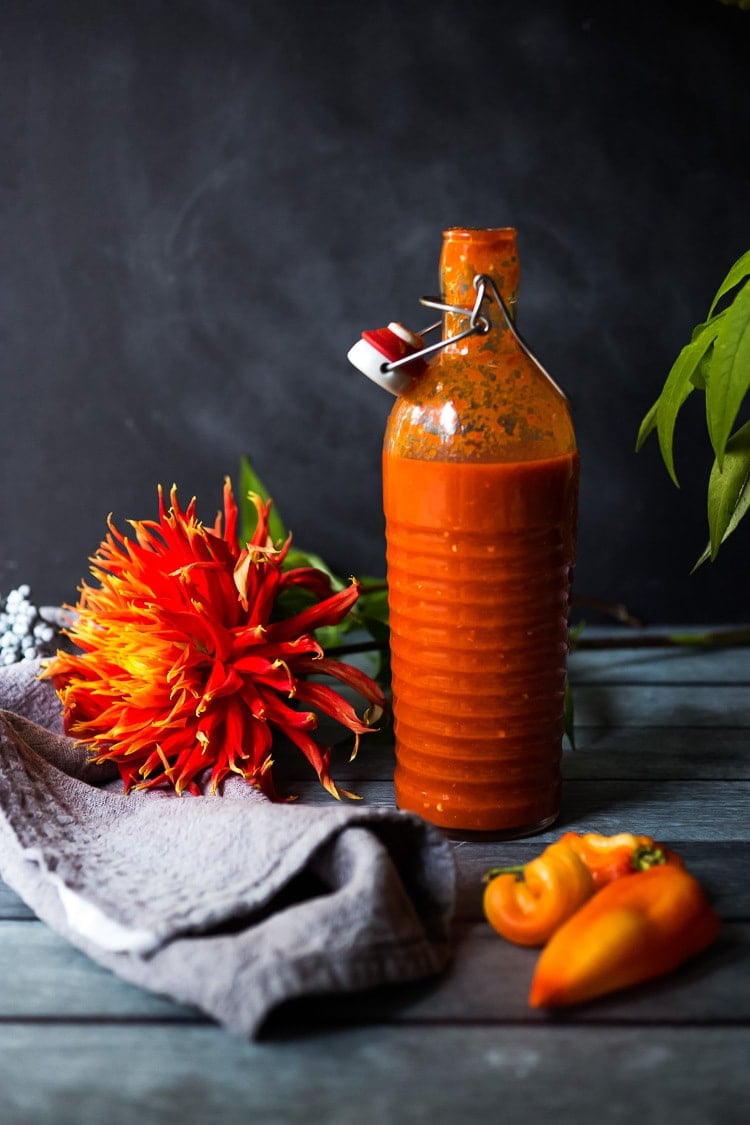
For many of you with gardens out there, this is the season of harvesting. Here’s a simple way to use all those chilies you’ve got growing out back and turn them into something that will bring you a little kiss of sunshine during the cold months – Fermented Hot Sauce! Now, before you feel intimidated – know that this only takes 20 minutes of actual hands-on time and no special equipment. It’s ridiculously easy!
Why I prefer fermenting over canning:
- Healthier: Fermentation creates “ALIVE” food- incredibly rich in probiotics. These good bacteria are living creatures that work with our microbiome to improve digestion, boost immunity, and prevent disease. Having a diverse microbiome is healthy! Canning “kills” all these healthy probiotics through the heating process.
- Taste: I prefer fermentation over “canning” because fermentation keeps these healthy bacteria alive, and as a result, the fermented food actually tastes better and better with time! Canning halts the development of flavor.
- It’s easier: Canning requires more hands-on time.
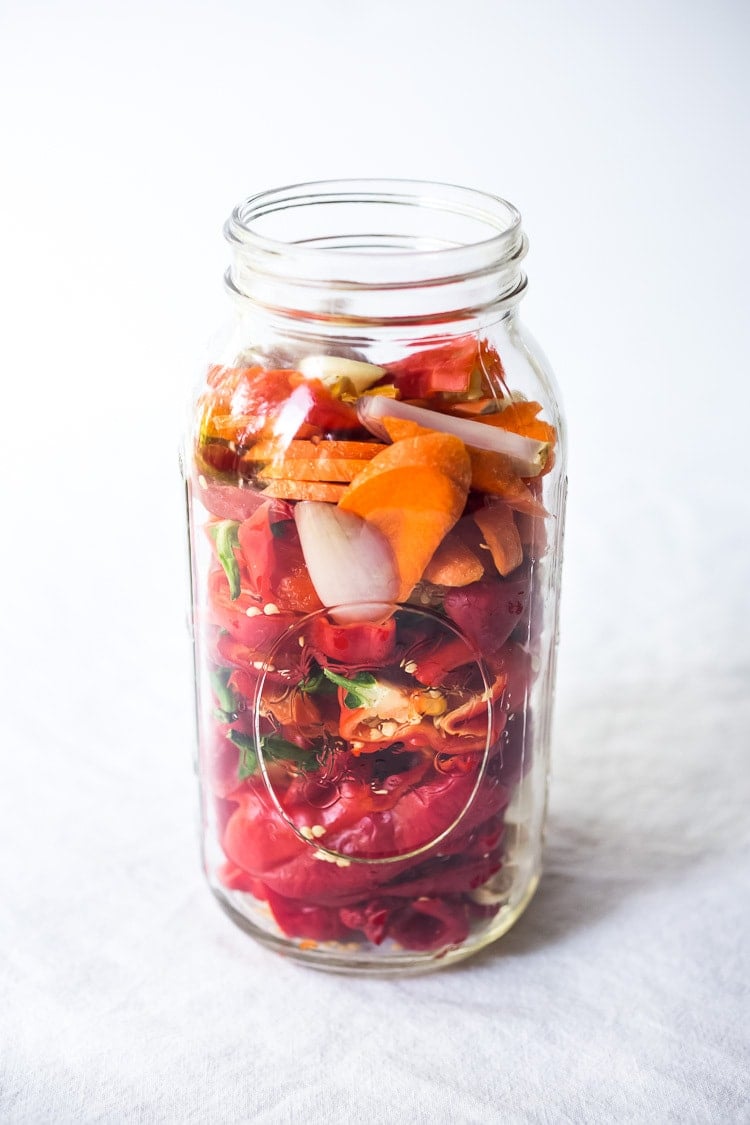
How to make Fermented Hot Sauce:
Step one: Fill a clean 2-quart jar with any type of fresh hot chili, onions, garlic and thinly sliced carrot. You can use bell peppers to temper the hot chilis if you want a milder version. Just stick with the same color palette so your fermented hot sauce stays colorful and vibrant.
In this recipe, I used Padrone Peppers, a Spanish variety that had turned red, which I found at our farmer’s market. But feel free to use any kind you want or a blend. You’ll need about 1 pound in total. (You can easily halve this recipe)
Step two: Make a saltwater brine, using 1 1/4 teaspoons fine sea salt, per 1cup of water.
Salt Ratio for Fermentation:
Having the right proportion of salt to water is important. Not enough salt may allow unhealthy bacteria to grow. Too much salt will kill all the bacteria and the chilies won’t ferment. If you need to add more water to the jar, then add salt accordingly.
Use 1 1/4 teaspoons fine sea salt per 1 cup of water. This is roughly a 3% Brine (3 grams of salt per 100g of water).
Here, I used 5 cups of water, so I added 1 1/4 teaspoon salt x 5 cups water = roughly 6 1/4 teaspoons of fine ground sea salt. Heating the water slightly helps the salt dissolve.
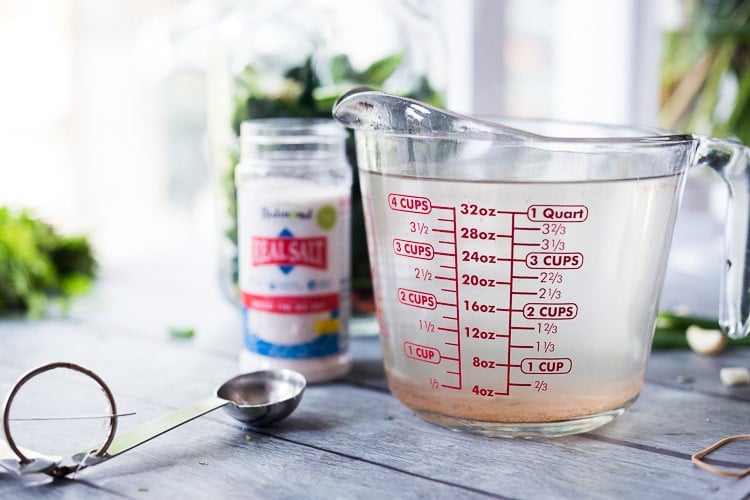
Step Three: Combine! Pour the brine over the chilies and push them down so they are completely submerged under the brine. Feel free to cover the chilies with a cabbage leaf to keep everything down, then weigh them down.
Step Four: Weigh down the chilies. You can use a fermentation weight, like this version that I really like, that will fit perfectly into a mason jar, to keep everything submerged. If anything floats to the top, and touches air, this can potentially mold, so either fish it out with a slotted spoon, or push it down under the brine.
Or in a pinch, a zip lock bag filled with water can be used as a weight, just place this over top. I prefer using a glass or ceramic weight.
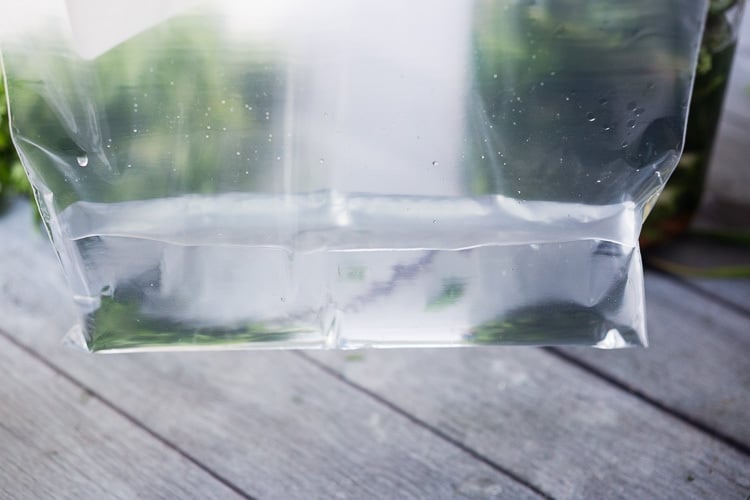
The water in the bag will work as the fermentation weight here. A small clean shot glass, placed over a cabbage leaf, can also act as a fermentation weight as well.
Here you can see I’m working on a mild green hot sauce which is in the fermenting phase still.
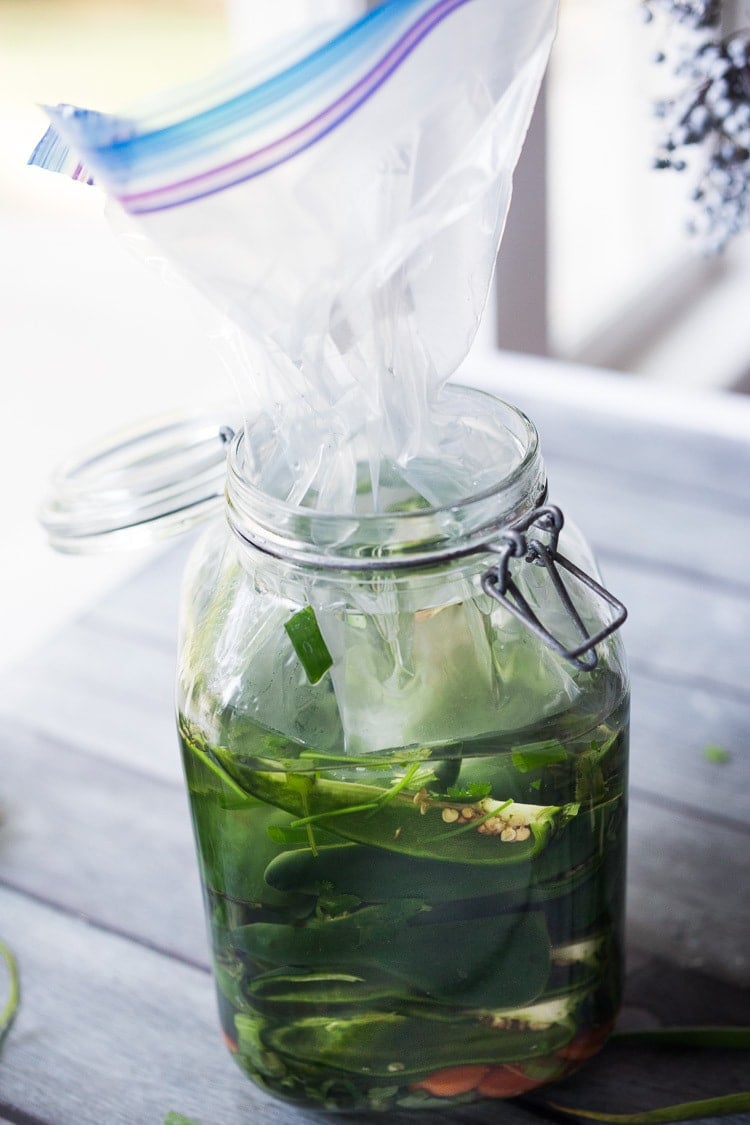
Step Five: Place a lid on top, leaving it loose. You want the fermentation gasses to be able to escape while keeping any creatures (bugs, flies) out. A couple of layers of cheesecloth also work here.
Step Six: Place the jar in a bowl or pan to catch any liquid that may spill over, and place it in a cool, dark place, like a basement. 65F-70F is ideal. If you don’t have a basement or a cool place, a lower cupboard in the kitchen is an option.
Check every few days, removing any “floaters”. After a few days, the brine will turn slightly cloudy, and when you tap the jar, you should see little bubbles float to the surface or some overflow on the pan- all signs of life!
Ferment 5-10 days. I usually go 7-12 days, long enough to soften those carrots, which you will be blending up in the sauce.
If, for some reason, you are going out of town, you can always place the ferment in your fridge, which will slow it down, but keep it alive, and you can resume when you get back.
Why is the Brine Cloudy?
Cloudy, tangy brine is a natural by-product of the fermentation process- a combination of lactic acid and yeast- and is the reason why they call it Lacto-fermentation.
Various strains of bacteria are present on the surface of all plants, especially ones growing close to the ground. Lactobacillus bacteria convert sugar into lactic acid, preserving the peppers.
Both salt and lactic acid prevent the growth of harmful bacteria. Over time, the cloudiness can settle out of the brine to the bottom of the jar. Some batches are naturally cloudier than others, but all are safe to consume.
A cloudy brine is a sign that you have a safe, successful, and tasty ferment.
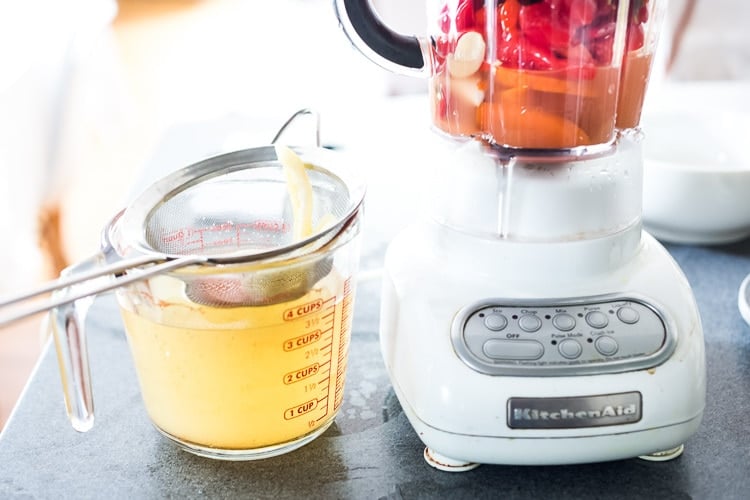
Step 7: Blend! Strain the brine, saving it. Add the strained chilies/carrots/garlic to the blender with one cup of brine and blend until smooth, a least a minute! At this point, you can add herbs (oregano or cilantro is nice here) and spices (cumin, coriander, chipotle). Add a little splash of Braggs apple cider vinegar if you like (this is optional but also full of healthy bacteria) and more brine to desired consistency.
If you like the idea Sriracha, you could also make it sweet by adding sugar or honey, and perhaps ginger. You could also add herbs.
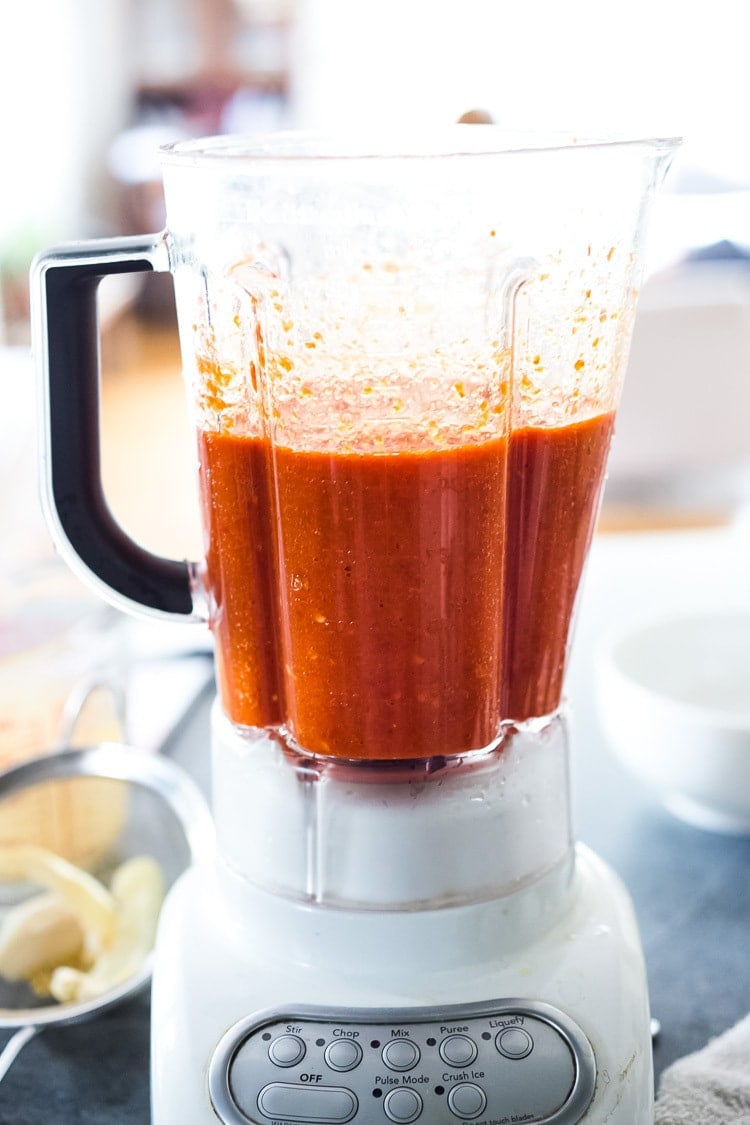
Step 8: Store! For everyday use, store the fermented hot sauce in squeeze bottles– leaving the tip off or open (or lightly closed) in the fridge. The hot sauce will continue to ferment in the fridge, and the open tip will allow the gasses out. Before using, cover the tip with your finger and give it a good shake.
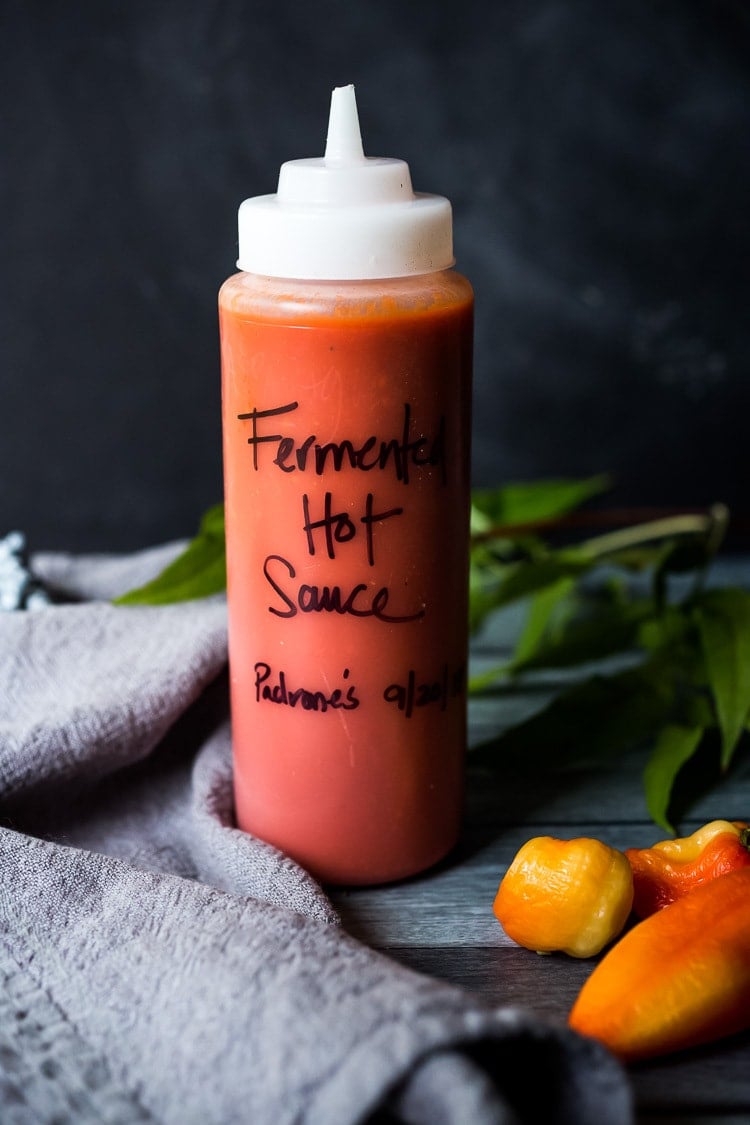
A little Warning!
If you place the fermented hot sauce in tightly sealed bottles, unrefrigerated, they will EXPLODE! This is because the hot sauce is still fermenting (producing gases) and will continue to create bubbles. Remember, it is alive, and this is NOT canning.
*If giving as a gift, yes, feel free to use a “cute bottle” but with instructions to refrigerate and loosen the lid.
But my hot sauce is way too hot!
Don’t be too alarmed if your hot sauce tastes overly hot when you first store it. After a week or two in the fridge, the gradual slow fermenting will substantially mellow out the heat! It’s quite surprising. Many times, I’ve made a hot sauce and tried it, thinking there was no way we would be able to eat it because of the heat level. But after a week or two, it really does calm down the heat. Fermenting the hot sauce gives it another layer of flavor, adding more and more complexity. This will keep indefinitely in the fridge.
Types of chilies to use:
Use any fresh chili pepper you like or a blend of different peppers (in the same color palate). To temper the heat, feel free to add similarly colored bell peppers (red, yellow, or green bell pepper). For example- add a golden bell pepper to habaneros to temper the heat. Or a green bellpeper to serano chilies.
Keep in mind you will be blending the sauce, so stick with the same color palate to make a vibrant-colored sauce. For example, mixing red and green peppers will yield a brown hot sauce- not the prettiest, but up to you. 😉
Also, keep in mind that fermentation will mellow out the heat of the peppers over time.
I am hearing that frozen peppers can be fermented ( please read the comments), but have not personally tried this.
Helpful tools
- Fermentation Kit (optional)
- Fermentation weights
- 2-quart mason jar (8-cup mason jar)
- Blender
- Strainer
- squeeze bottles
Making Fermented Hot sauce is a fun little project that only takes about 20 minutes of hands-on time. A lovely way to use up all the chilis in your garden (or a way to try out all the beautiful varieties at the farmers market) and a healthy way to bring more healthy probiotics into your life!
Mother Nature will do all the work for you! And after 5-7 days, you will end up with the most delicious, alive hot sauce that will get better and better with age!
Troubleshooting
- If there are no signs of fermentation, double-check you measured the salt ratio correctly. This is typically the most common problem (adding too much salt will halt the process and kill all the bacteria, even the good ones.).
- Try filtered water. Chlorinated water can halt fermentation.
- Do not over-wash or peel the peppers/carrots (for example, don’t use any type of produce soap) as the wild bacteria from the pepper skin, carrot peeling is what is starting the fermentation. I have the best luck with farmers’ market chili peppers and carrots because they are not over-cleaned or treated with anything.
- Mold: If your ferment has molded, something likely rose to the top of the jar and had contact with air. I would start over.
- Bad smell: the brine should smell tangy, garlic, and fresh, not “foul” in any way! If it smells “off,” it could be that salt was mismeasured or the ferment was contaminated: dirty hands, dirty utensils, dirty jar.
More Favorite Recipes!
- Yum Yum Sauce
- How to Make Kimchi!
- Simple Cabbage Sauerkraut
- Beet and Cabbage Sauerkraut
- Probiotic Gut Shot
- Curtido & Cultured Salvadoran Slaw
- How to make Fermented Pickles!
More from Feasting At Home
Watch HoW to make Fermented Hot Sauce!
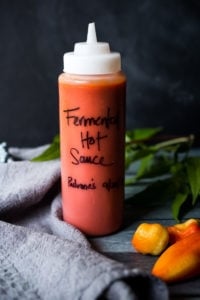
Fermented Hot Sauce
- Prep Time: 20 minutes
- Cook Time: 5 days
- Total Time: 120 hours 20 minutes
- Yield: 4 cups
- Category: Sauces, fermenting, preserving
- Method: fermenting
- Cuisine: American
- Diet: Vegan
Description
A simple, delicious recipe for Fermented Hot Sauce using fresh summer chilies, with no special equipment and only 20 minutes of hands-on time!
Ingredients
Saltwater Brine: ( 1 1/4 teaspoon salt per 1 cup of warm water) This is roughly a 3% Brine. (3 grams of salt per 100g of water)
- 5 cups filtered water
- 6 1/4 teaspoons finely ground sea salt (or Pink Himalayan salt) – use 1 1/4 teaspoon salt, per 1 cup of water.
- 2 Quart Mason Jar
Fillings:
- 16 ounces fresh chili peppers, sliced in half (about 6-7 cups) seeds & stem removed, see notes
- 1 carrot, very thinly sliced 1/16th-inch (do not peel!)
- 4–8 garlic cloves, cut into quarters
- 1–2 shallots, sliced (or 1/2 an onion)
After fermenting, add optional seasonings to taste. Keep in mind the “heat” will mellow with age.
- optional: herbs (oregano, cilantro, celery leaves) and spices (cumin, coriander, chipotle powder, smoked paprika)
- 1–3 tablespoons apple cider vinegar, (optional- for extra tang and for more healthy probiotics)
- honey or sugar to taste (optional, good if making Sriracha style)
- If your hot sauce is not hot enough, you can always add cayenne or ground chipotle to taste. Free free to add spices ( 1/2- 1 teaspoon) cumin, coriander, chipotle, allspice, etc. Make this your own.
Instructions
- Wash your hands, jar and ustensils. Not sterilized, just clean. 🙂
- Stir sea salt into the water until dissolved.
- Slice the small hot peppers in half, and remove stems and seeds if you like (for less heat). If your pepper are very hot, wear gloves. If adding bell peppers to temper the heat, cut into thin strips. Thinly slice the carrot (do not peel), slice the shallots, and slice the garlic.
- Layer all into a clean 2-quart mason jar. Top with a cabbage leaf to hold things down (optional) and pour the brine into the jar over the chilies, pressing them down under the liquid. If you need to add more brine, remember to use the ratio of 1 1/4 teaspoon salt per 1 cup of water.
- Weigh everything down with a fermentation weight (or use a small ziplock bag filled with water to weigh the veggies down or try a clean shot glass). You want the chilies completely submerged under the brine. Anything that touches air, may mold, so either spoon it out or push it down. Cover loosely with a lid ( or cheesecloth and rubber band) and place the jar in a pan or bowl to collect any liquid that may bubble over. The lid is loose here so gasses can escape easily, but no creatures can get in.)
- Place in a cool dark place, like the basement, 65-70F is ideal, (or the bottom cupboard in the kitchen) for 5-10 days or until signs of fermentation.
- On day 3-5: Check for fermentation: Tap the container and see if any tiny bubbles rise to the surface, check for a cloudy brine ( see notes) or check the bowl underneath, to see if there was any overflow. All signs of activity! Ferment 7-10 days, long enough to soften those carrots that you will be blending. And you can always ferment longer for even more flavor- I’ll often ferment 12 -14 days. Sometimes I’ll ferment 7 days, then place the jar in the fridge for a few weeks before blending. The longer the ferment, the tangier and more flavorful this will become, and the more mellow the heat. *If there are no signs of fermentation, give it a couple more days- then check the troubleshooting section in the post.
- After 7 days and signs of fermentation, strain and SAVE the brine. Place the fermented peppers, onions, garlic, and carrots into a blender and discard the cabbage leaf. Add 1 cup of the brine and blend until smooth as possible. This may take a couple of minutes. Add the vinegar if using, (and honey if you prefer a sweeter hot sauce like Sriracha), and more brine to desired thickness. At this point, you can blend in optional spices and herbs. ( 1/2-1 teaspoon spices, 1-2 tablespoons fresh herbs).
- Don’t be alarmed if it is overly spicy- the heat level will significantly mellow with time, as it continues to ferment in the fridge after 1-2 weeks. Place in a squeeze bottle and store in the fridge, leaving the tip open (or loose) for gasses to escape.
- Do not place in a sealed jar unrefrigerated– this will result in an explosion– and a great big mess- as the hot sauce is still alive and fermenting! BE WARNED! I have the best luck with using in squeeze bottles and leaving the cap off in the fridge.
- If transporting to a friend as a gift, it is ok to seal for short periods of time (a few hours) but make sure to tell them to refrigerate it and loosen the lid, very soon after receiving.
- The flavors will continue to develop and get more complex over time, the heat mellowing.
- To use, cover the tip of the opening with your finger and give a shake before using.
- This will keep up to 12 months in the fridge (probably even longer!).
Notes
WATER: Regular tap water may contain too much chlorine in it, inhibiting the fermentation process (although our tap water works fine). If fermentation is not happening, you may want to try filtered water.
SALT: I use fine ground sea salt or Pink Himalayan salt . If using coarse ground salt you may need to add a pinch more.
Peppers: Use any chili pepper you like or a blend of different peppers (in the same color palate). To temper, the heat, feel free to add similar colored bell pepper -substitute sweet red, yellow, or green bell pepper. Keep in mind, you will be blending the sauce, so stick with the same color scheme to make a vibrant colored sauce. For example, mixing red and green peppers will result in a brown hot sauce– but up to you. 😉 Also, keep in mind, the fermentation will mellow the heat a little. Removing the seeds will help temper the heat.
RATIO: If you need more water to cover or fill the jar, use 1 1/4 teaspoon salt per cup of warm water.
You could easily halve this recipe or use two, quart-sized jars.
CLOUDY BRINE: A cloudy brine is a natural by-product of the fermentation process-a combination of lactic acid and yeast and is the reason why they call it Lacto-fermentation. It is a sign of fermentation. Various strains of bacteria are present on the surface of all plants, especially ones growing close to the ground. Lactobacillus bacteria convert sugar into lactic acid, preserving the peppers.Lactic acid prevents the growth of harmful bacteria. Over time the cloudiness can settle out of the brine to the bottom of the jar. Some batches are naturally cloudier than others, but all are safe to consume and taste delicious. A cloudy brine is a sign that you have a safe and successful ferment.
Signs of fermentation: liquid overflowing into the bowl (check the bowl to see if the jar overflowed, a good sign! Tiny bubbles rising to the top when you tap the jar. Cloudy brine, tangy flavor or smell.
Nutrition
- Serving Size: 1 tablespoon
- Calories: 4
- Sugar: 0.4 g
- Sodium: 112.3 mg
- Fat: 0 g
- Saturated Fat: 0 g
- Carbohydrates: 0.9 g
- Fiber: 0.2 g
- Protein: 0.1 g
- Cholesterol: 0 mg
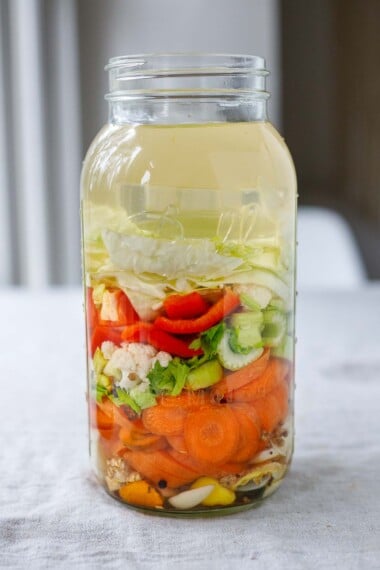
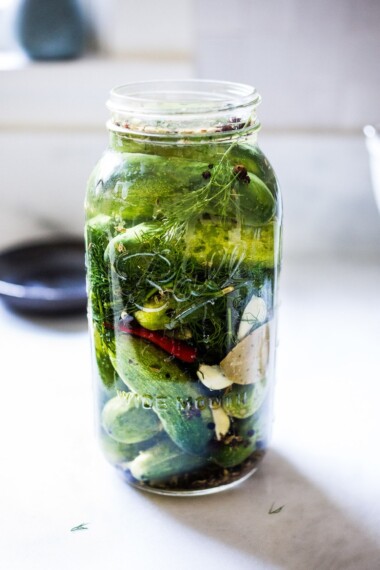
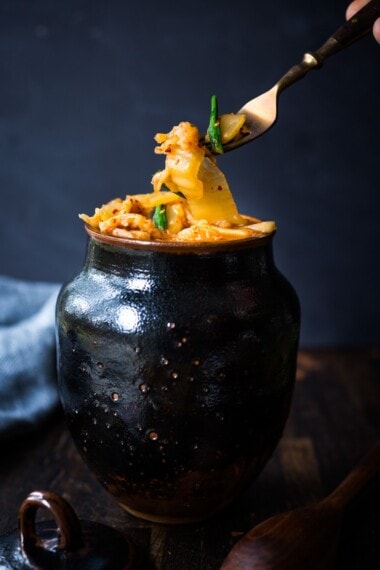
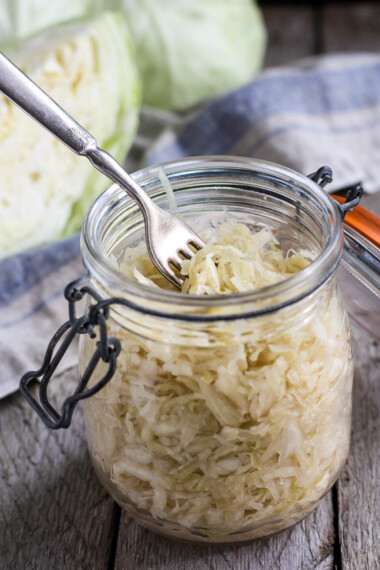
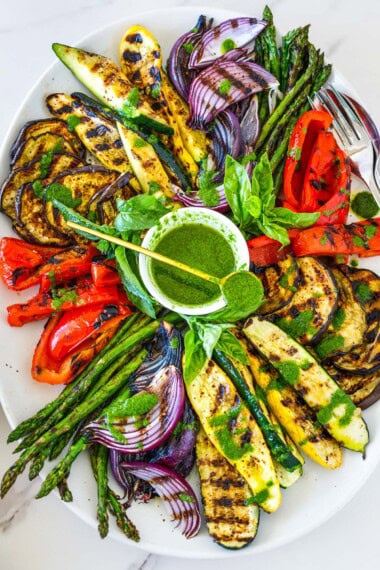



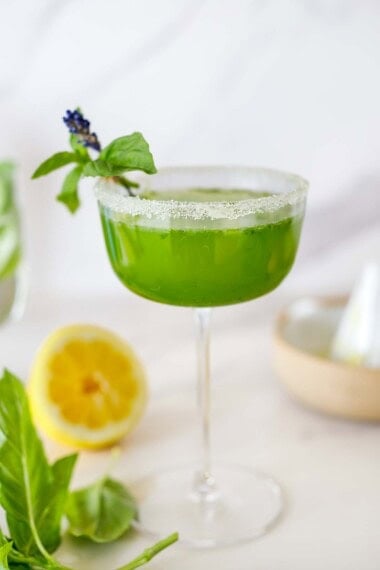
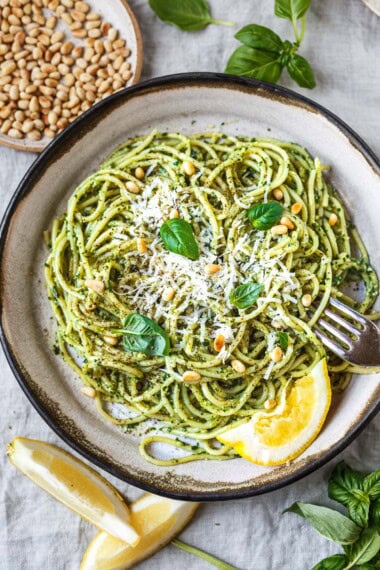
Hi, did you have any luck trying to ferment dried chilies?
Hi Vince- I am still working on this! Will report back next week!
I have jars sitting on my counter for months that i have not touched. are they still safe to move onto the blending step?
Hi Heddy- do they have signs of fermentation- bubbly when you tap the jar? Smells good and sour? If they are fermented they are safe. 🙂
One smells sour and good i think, the other jar not so sure. neither have bubbles anymore and the bottom of both have a layer of something whiteish
Use the one that smells sour!
A family member wants me to mail some of my completed sauce, but I am worried that it may explode during transit. Will it be fine for up to a week in the post. How worried should I be?
No Don! Do not mail- it can explode!
I made this with a batch of scotch bonnet chillis, red birdseye and green birdseye chillis. Left them to ferment for 3 week. Turned out so good, thanks! The scotch bonnet batch was way more potent and flavourful so I’ll be using those again. Excellent, clear, helpful instructions, I’m really grateful! Fantastic recipe and very easy. Thanks again. I’ll be experimenting by adding fruits to my next experiment.
Thanks Claire- sounds delicious!
Hi Sylvia, I noticed in the ingredients you said about removing the seeds from the peppers and to see notes, I didn’t see anything about it, could you please explain about the seeds. Thanks in advance. Rob
Hi Rob- the “see notes” is more about the peppers themselves, not about the “removing seeds”.:) But… removing seeds tempers the heat a bit- and also prevents them from floating to the top where, if they touch air, can get moldy. Sometimes I leave the seeds in the peppers and leave the peppers whole to prevent this. Either way works. 🙂
I am on my Third ferment, a pineapple scotch bonnet sauce. I made a mango reaper and a mango scorpion sauce, which were both amazing. I was wondering how long the leftover brine will keep in the fridge?
Sounds delicious! It should last indefinitely.
Hi,
i’ve been trying to make the brine but the last couple batches have grown mold by day 5. the top of the water had a kind of white film. Is that truly mold, or might it be yeast? i cleaned everything well, and used cheesecloth and a rubber band to secure it before putting it in a dark room in the basement. do you think i need to use a different lid, or change locations?
I can’t be sure without seeing it. If your peppers reached above the surface, then it can be mold. If not, and everything is submerged, then it could be kahm yeast, but this has more of a cloudy effect in the brine itself, not a solid thick surface. You could google Kahm yeast and compare photos? If it smells “moldy” I would toss it, to be safe.
I had two ferments going, but was away for a few days. When I checked some of my fruits/veggies are pushed up above the brine. The weight slip off to the side. One is only slightly above the brine, while the other has a significant amount above the brine. Should I scrap the whole thing?
Hi Don, no don’t scrap! If you don’t see any mold, it is probably fine! Try removing those exposed veggies if you like.
Thanks for the tip. I did not see any mold. I forgot to mention that I had airlocks on both jars.
I’m sure it is fine then!
Other hot sauce ferment guides talk about how important it is to not let oxygen get into the jar, sealing the jar airtight etc. But you suggest the opposite.. now I’m super confused.
Hi love this…
I want to try to make a small business for this. If you dont mind..
But i still wondering about the packaging/bottles. Should i keep the bottle open until it is sold? As you said “Do not place in a sealed jar unrefrigerated– this will result in an explosion”
Need your guide please. Thanks, stay safe!
Hi Farius- I’m sorry, I don’t know a good way to seal this for selling. You would have to test it.
Farius, you’ll need to pasteurize your hot sauces for long term shelf stability, and depending on where you live it is likely the law. You’ll also want to check any commercial regulations that will apply to your business. Google hot sauce pasteurization for details, also the hot fill method. You’re essentially killing off any and all bacteria, and that not only makes it safe and shelf stable, it also completely halts fermentation.
Thanks Paul. Appreciated! 🙂
I used your recipe last year and had a great success with red ghost peppers. I added some apple cider vinegar to taste, and wow was it ever good.
This year I did the basic recipe with two one liter jars of yellow ghost peppers. After two weeks, I blended each jar with 4 tablespoons of local honey from a friend. The color is a vibrant yellow, and the taste is amazing. I’ve done other sauces with peppers from my garden, including ghost, reaper and habanero, but none come close to the fermented sauce. It’s simply delicious. The honey just takes it over the top. I’m now addicted. I put this stuff on everything.
I’m so glad you like this Daniel~ I need to try honey now! Love it.
Thanks for the recipe and method, it was pretty easy, and the results are delicious, so far. I had an overflow of srirachas after the plant fell over (from all of its weight, I guess) and had to find some way to use them all. I used double-layered cheese cloth on mason jars secured in place with the jars’s screw tops. Kept the seeds, 3 different varieties; very nice and cloudy looking brine after a week which smelled amazing even before blending anything together.
Great to hear!
Thanks to you my first lacto fermentation was a success! I have a lovely tang in my fermented liquid but I didn’t need to use very much of it at all to get to the right consistency in my hot sauce. I hate to just throw out this living liquid. Any tips on how else to use the excess liquid?
Thanks!
Hesham, you can reuse to make another batch. Congrats by the way!
Hey, wine making guy here. Frozen fruits and vegetables are perfectly fine for fermenting – it breaks down cell walls when the water forms crystals, which is useful for flavor extraction . Something to note for this type of fermentation is that you’re relying on natural yeast which might not survive a freeze so using a portion of fresh produce should allow for fermentation still.
Appreciate this Noah!
Turned out great! 10 day ferment, mixed hot peppers, garlic, red onion, carrots. Added a little honey to taste. Thanks!
Perfect, love it Dana!
Looks good am going to make this one.
Perfect- let us know how it goes, Miriam!
Amazing recipe! This is my second time making it. The first time I added cherries and peaches along with the carrots, peppers, garlic and onions. After 3-4 weeks the sauce had changed flavour and I put it on everything. It was so good.
This time, I used the same ingredients however added red kale stems, a mango and tomatillos in place of the peach and cherries. I let it ferment for 8 days. Can’t wait to taste it in a few weeks.
Love how creative you are getting with this- sounds amazing Randy!
I made a mistake and added vinegar at the start! Not a lot – maybe a tablespoon it 2… Have I ruined my ferment??
You may have, unfortunately. The vinegar may prevent fermentation?
It depends on the quantity of vinegar to brine ratio. The recipe I use for fermented peppers calls for 1 TBS of vinegar along with the brine. How did it turn out? When fermenting I always just let do it’s thing for a few days to see how it goes, even when I think I’ve made a mistake.
When storing/fermenting.. should I drain the liquid that collects in the catch bowl? I don’t want to grow mold by accident.
Feel free to empty it if needed. 🙂
You can use frozen. I have a batch fermenting now that was mainly frozen peppers. The fresh carrot and onion will lend the bacteria needed to start the fermentation process. My batch took off like crazy after day 1! Fermenting 1lb 5oz of ghost pepper with whole onion, 1 carrot and about 9 cloves of garlic. Also have a ferment of 1.25lb red bell with a whole onion, 1 carrot and 4 cloves of garlic to temper with when i blend.
Thanks Clint! helpful!
I’m a bit concerned about leaving the squeeze bottles uncovered in the refrigerator. It doesn’t seem very sanitary. How long do you do that?
Hi, feel free to cover loosely with a lid if that makes you more comfortable. 😉 Because it is still fermenting, having a tight seal will create pressure. The amount of salt here prevents the growth of mold or bad bacteria- I’ve had my squeeze bottle in the fridge for months now, never EVER mold or unwanted bacteria. I’ve never had a problem with it! You have to remember, it is a living “breathing” thing. 🙂 Like a pet!
You can pasturize before bottling, but that will stop fermentation and kill the probiotics. As long as you can obtain a ph of 3.4 or lower, will have good shelf life outside fridge.
When you are happy with the result and want to store is safely, just heat treat your sauce to stop the fermentation process.
Just a few minutes at 72C-161F is enough to store it safely on a shelf.
Best done in a water bath in the oven or with a circulator.
Just make sure the complete contents of the sauce have reached to required temperature to stop the fermentation.
The taste remains the same.
Can you please describe the heat treat process more in depth. We are making our second batch and love it.
Hi! Awesome recipe. Are there any herbs that would hinder the fermentation process? I am considering adding rosemary prior to fermenting. Also are there any fruits that do not ferment well? I was thinking of also making a fermented pineapple habanero sauce.
I think both should work fine!
Oranges are the one fruit that gets avoided. Pineapples do great.
Can I ask why oranges should not be used. Is it the same for orange rind?
Thanks!👍
Almost any fruit is fine, if it’s overly acidic it can be a problem though.
For herbs, when you ferment the flavors can become really pronounced really quick which is why in a lot of cases you wait to add them. You can always add later and taste by the day, but you can’t take taste away
Thanks Noah!
Awesome, make it for people at work. They all enjoy.
Thanks Erie! Love that you share this!
This is awesome!! Can you save / reuse the fermentation liquid
People have been reusing, but I havent personally tried. It’s also good added to soups, stews…
I used some of the leftover ferment in a batch of sauerkraut and it turned out amazing.
Oh man! I bet that was nice! Transfer a lil spice tobthe kraut!
I would recomend that, your next fermentation will start fermenting much faster because of all the bacteria in the brine
Just wondering why you want the carrots unpeeled.
Thx!
Hi Lisa- the wild bacteria on the skin of the carrots help the peppers ferment.
And the nutrients too!
Can you / have you tried adding herbs and spices in the ferment rather than after?
(PS. Great recipe. Turned out great! I used 50/50 Jalapenos and green apples, then heavy on the vinegar after it was blended)
Yes, I’ve done it both ways with herbs. I tried adding whole seeds (cumin and coriander) to the ferment, but they floated up and got past the fermentation weight and molded- so I wont do that again, but the herbs stayed down fine!
Perhaps a bouquet garni with the herbs and seeds to keep together and weighted down?
Great idea Mark!